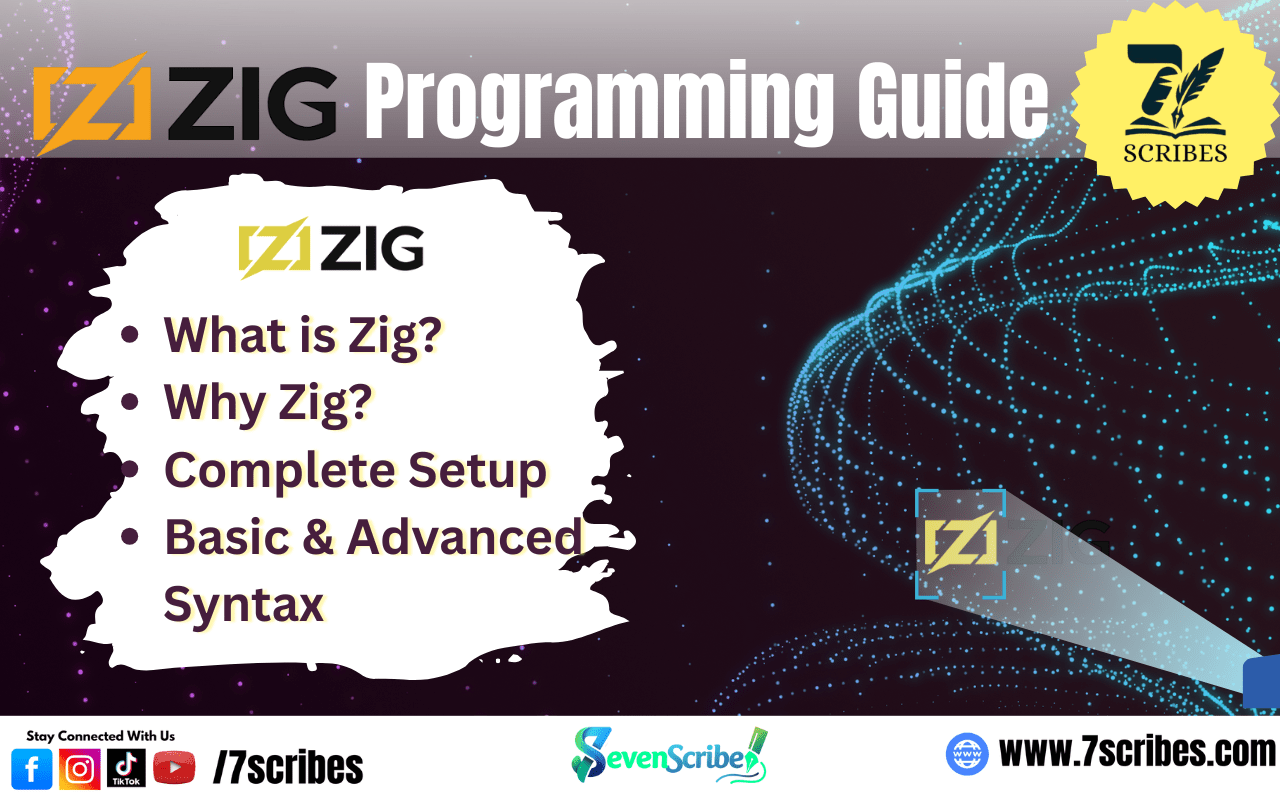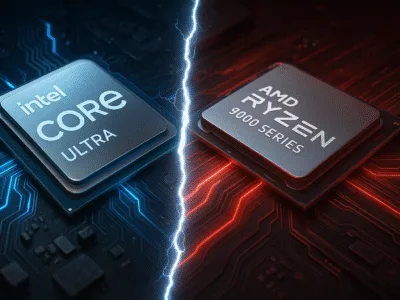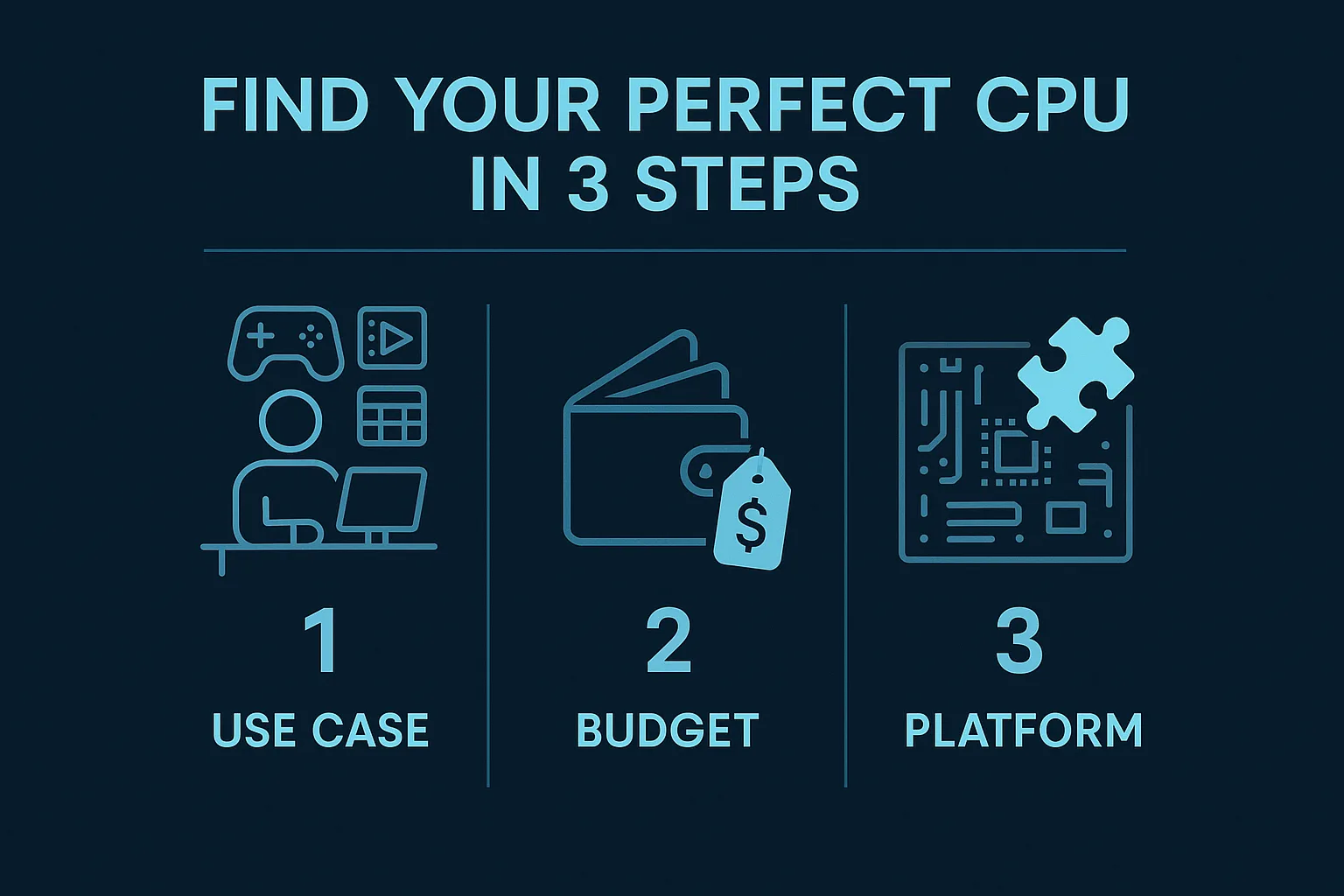Abstracts
Zig programming is one of the new programming languages that is gaining popularity in 2025. It was developed by Andrew Kelley in 2016. It is simple, easy, safe, and fast, making it a great choice for programmers who develop software for gadgets, computers, or games. It is just like other programming languages, C, C++, but simpler and easier to use. It is the best choice for programmers who want to better control their code.
The main question is Why is Zig special?
The answer is pretty simple that Zig lets you manage memory yourself and helps you avoid mistakes. It does not require a heavy system to run. The feature “comptime” of Zig lets you write code that runs when building a program without requiring tricky extra things. The other key thing is that it works smoothly with the old C code; it is an extra edge that helps you to update your existing projects easily. In 2025, developers will use Zig for things like games, small embedded devices, and web-based applications.
This Ultimate Guide to Zig Programming in 2025 is for anyone curious about Zig programming. Whether you are a pro at coding, a worker with an embedded system, or new to programming. This article will cover what Zig Programming is, its best features, how to set it up, basic and advanced coding, real-world uses, and what is next for Zig programming. By reading this article, you will find why learning Zig programming is important and how to start using it. Ready to learn about this newly born programming language? Let’s get started.
What is Zig?
Zig is a programming language that allows writing code fast, easily, and securely. It was developed by Andrew Kelley in 2015. Its primary objective is to resolve issues in other programming languages, especially C and C++. It is not yet mature, but has grown a lot, and new updates over time make it an even better programming language for programmers who want to work with Zig programming.
It keeps things simpler and easier to avoid complexity and difficult to learn, which is why it has better performance and is more secure than other languages. It is developed with simple features means it does not include complex features that affect speed and overall performance of the program or code. There is no need for a complex or heavy machine to run Zig software. These features make Zig is best choice for projects where speed and reliability are essential.
In comparison with other programming languages like C and C++. These languages are powerful but not risk-free; they come with issues like bugs and chances of crashes, and other issues related to runtime errors and memory management issues. But Zig comes with a solution for drawing these languages (C, C++), that is, it is safer and easier to use while keeping control over the program. Rust is one of the secure programming languages, but its rules are difficult to learn; Zig rules and less strict than Rust. Go programming language is simple but less focused on low-level tasks, which are handled very well by the Zig language. Zig comes with a mix of ease, speed, efficiency, and flexibility that makes it the best choice for programming.
As the Vice President of Zig Foundation, Mrs. Loris Cro defines the zig programming language as “It is a general purpose programming language due to it is efficient for system programming, also good for developing embedded systems, games, and many other tasks handled by high-level programming.
Why Zig Programming in 2025?
The main question that why we choose Zig programming for developing software in 2025 and the future.
Every programming language has its pros and cons. Each programming language has its uses and drawbacks. For a while, when we discuss the Go programming language, it is easy to learn, efficient in performance, and has robust concurrency support. But the disadvantages of the GO language are time-consuming, small, and has a developing community. If we discuss the C and C++ languages, they are the fastest programming languages, secure and efficient, but the main drawback of these languages is that they have strict rules for syntax, also need to manage memory.
Advantages:
Here, is the some major advantages of Zig programming over other languages.
1. Manual Memory Management
Zig language gives developers or programmers explicit control over memory management. It avoids hidden allocation and provides precise control, showing many errors at compile time.
2. No Hidden Runtime/Control Flow or Allocations:
Zig programming enables everything visible to the programmers in the source code, with no hidden allocations and runtime overhead. This makes it ideal for system programming and developing embedded devices.
3. Compile Time Programming
Zig language introduces a function name as comptime, which is the mechanisms that allow code to execute at compile time.
example :
const std = @import(“std”);
fn square(x: i32) i32 {
return x * x;
}
pub fn main() void {
const result = comptime square(5); // evaluated at compile time
std.debug.print(“Square: {}\n”, .{result});
}
4. Interoperability with the C language
Zig language allows calling C libraries and even code directly using its own compiler. This allows programmers with a C background and software developed with the C language to integrate easily with the code that is written in the Zig language.
Drawbacks
There are some major drawbacks to Zig programming:
1. Immature Ecosystem
Zig has a small community but a growing language. It has fewer libraries as compared to other languages like C, C++, and Rust etc. There is no valid or mature framework for web development.
2. Steep Learning Curve
Zig programming requires a deep understanding of Zig concepts, and manual memory management is challenging for developers.
3. No Garbage Collector
There is no garbage collector in the Zig language, which means developers have to be diligent about memory management, which leads to an extra burden on developers.
Setup Guide:
Step No: 01
Go to the official site ziglang, and click on the first result as shown below.
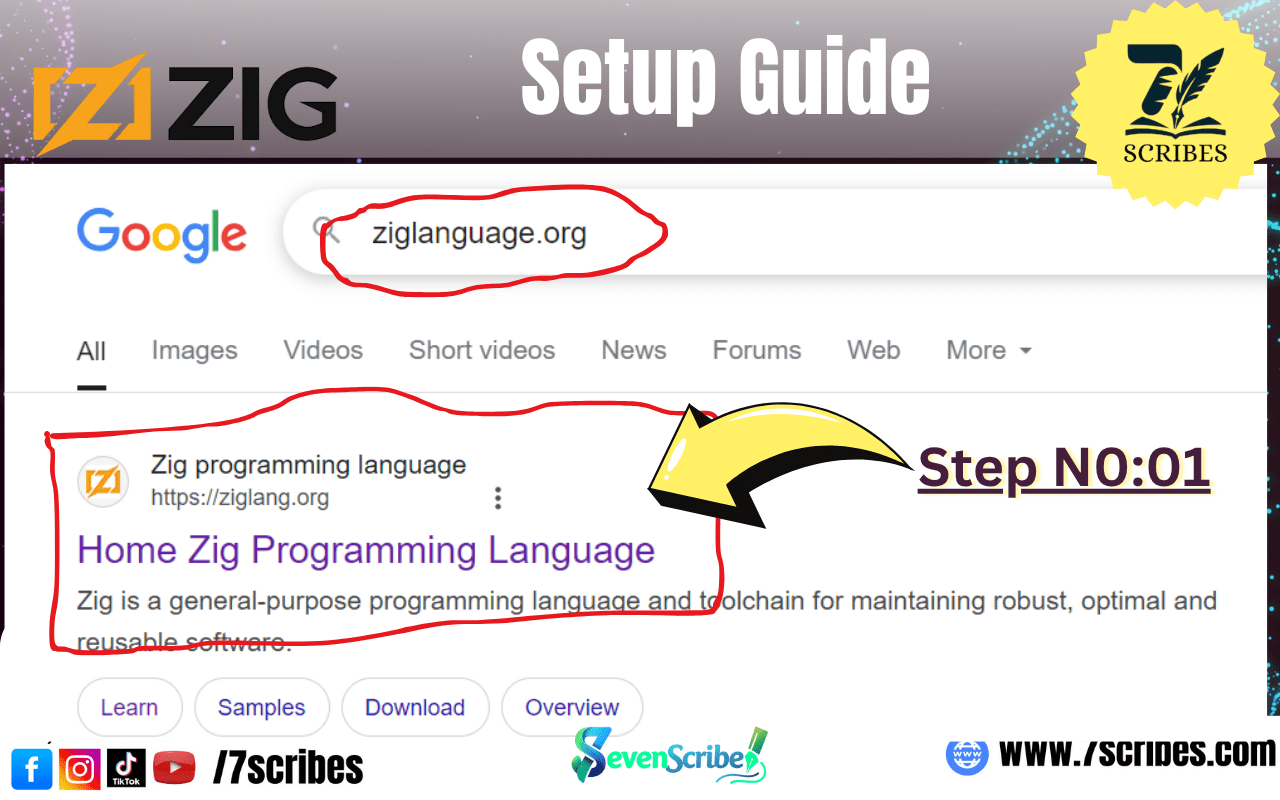
Step No:02
When you come to the homepage, click on the download page.
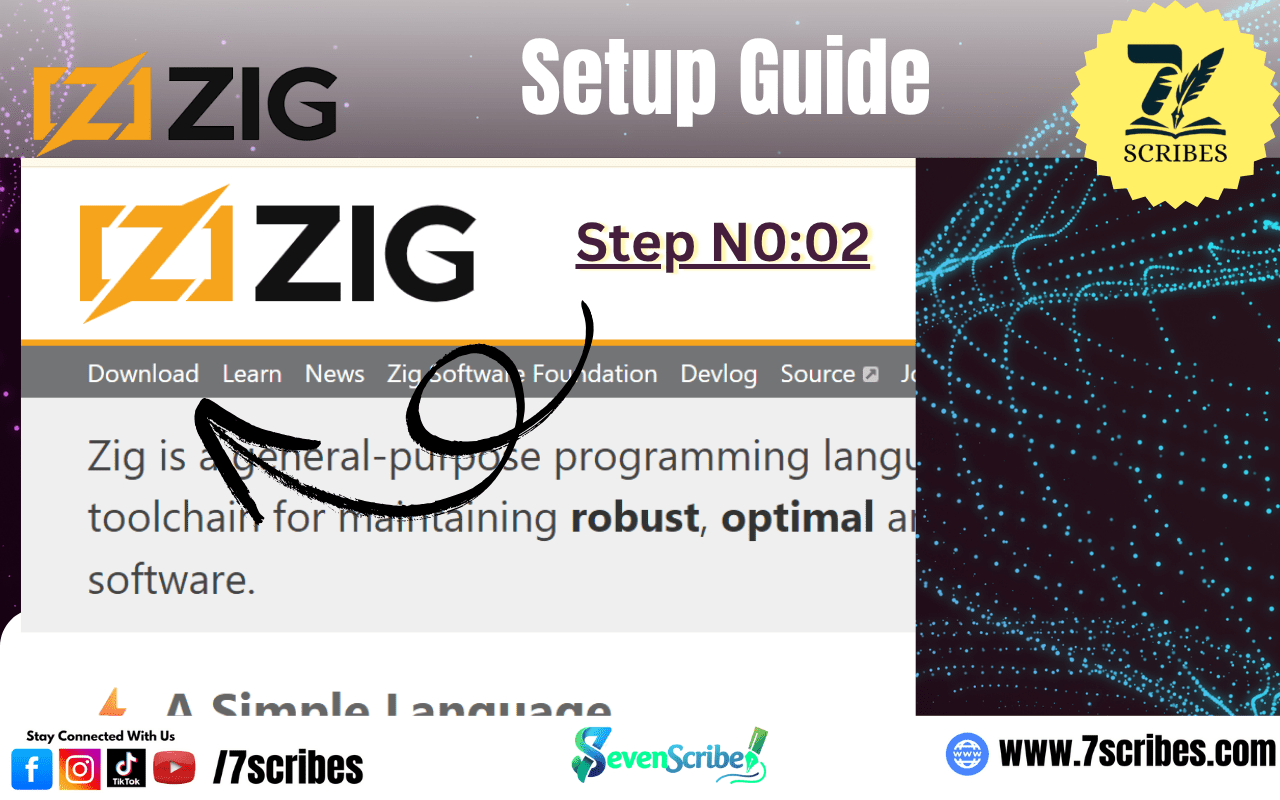 Step No:03
Step No:03When you come to the download page, select the compiler according to your system, i.e., Windows, Linux, etc. Here, we show steps for the Windows operating system.
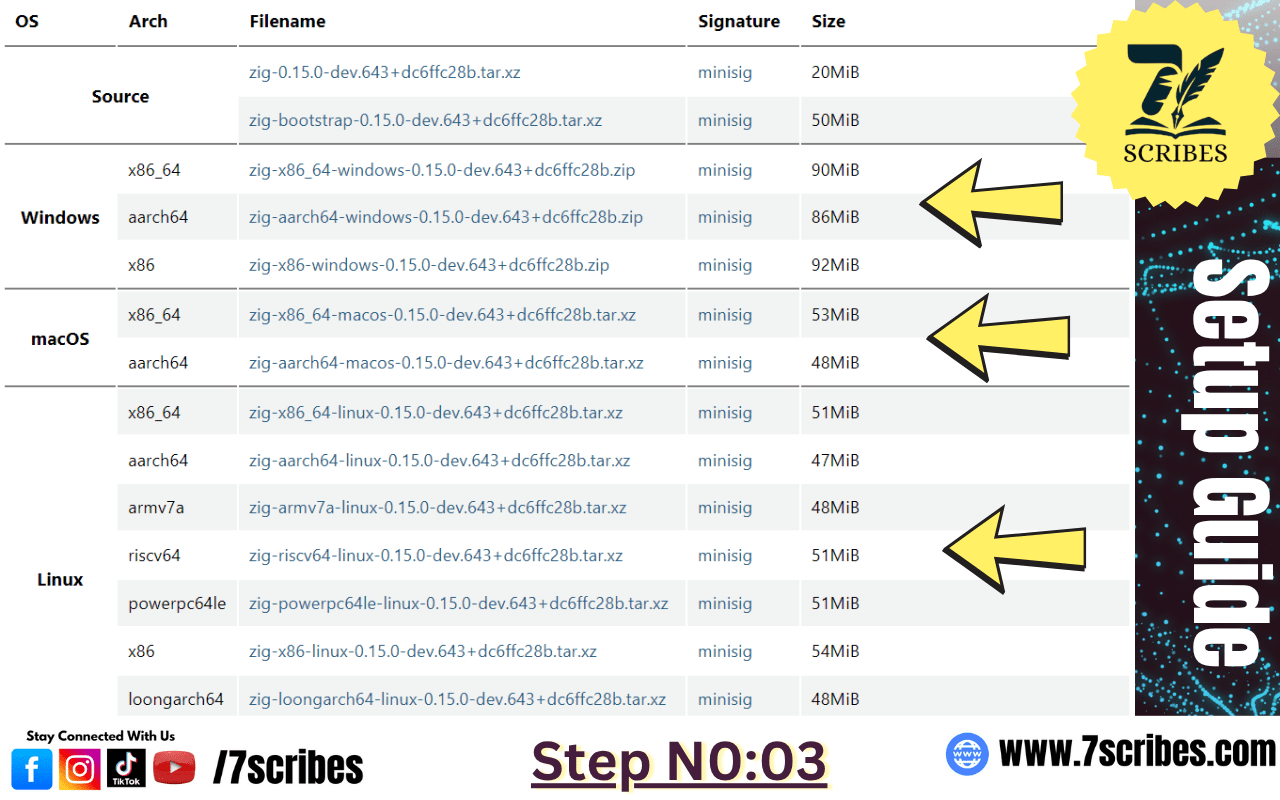 Step No:04
Step No:04In this step, extract the zip folder of the zig download file and include the path in the global environmental setup.
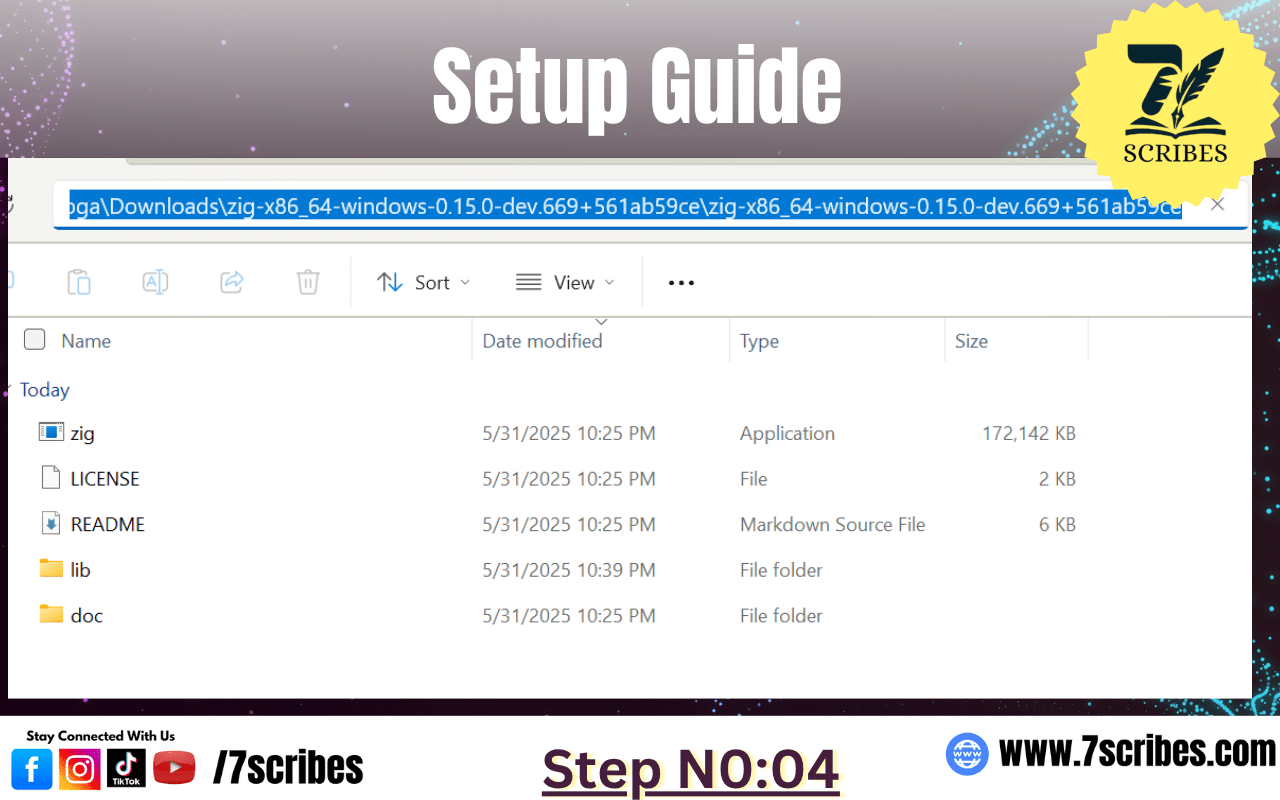
Step No: 05
Check the version of Zig language by typing “zig– version” in the command prompt of the system.
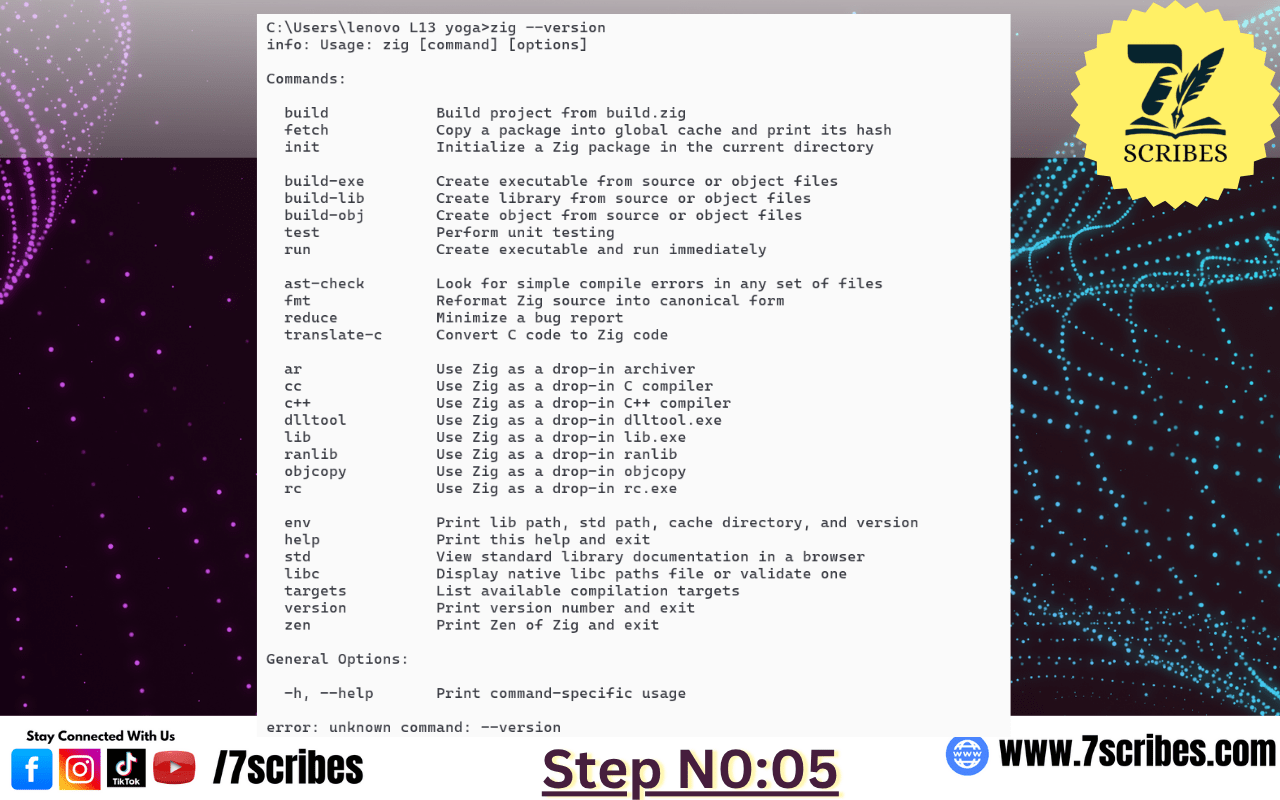
First Program:
Now, here is the first program in the Zig language printing “Hello 7scribes“.
const std = @import(“std”);
pub fn main() !void
{
const stdout = std.io.getStdOut().writer();
try stdout.print(“Hello, World!\n”, .{});
}
Real World Uses of Zig Programming
Now, we discuss where in real world applications and systems uses zig programming or not here is the some real world application of zig language. Zig language is used systems due to it is ease to learn, implement and safety is crucial.
1.Operating Systems and Kernels:
Zig program is ideal for operating system and kernel development due to it precise memory control, efficiency and hardware interaction capability, C interpeobility and compile time safety.
2. Device Drivers and Embedded Systems:
The zig programming support no runtime or garbage collection, direct access to headware, interoperability with C, and compile time code execution that are essential for device drivers and embedded systems where programming is not frequently change.
4. Game Development:
Zig programming alow to devloped web based application using webassembly.In game development the security, memoryanagement and user interface are critical things that should be work smoothly without any affect on overall performance of software.
Here is some projects developed using zig programming:
- Bun (System Tools & Utilities)
- Ghostty (System Tools & Utilities)
- TigerBeetle (Database)
- Mach Engine (Game Development & Graphics)
- MiniPixel (Game Development & Graphics)
- libp2p-zig (Web & Networking)
- translate-c (Development Tools & Libraries)
- zig-ecs (Development Tools & Libraries)
- Sig (Web & Networking)
Future of Zig Programming
The future of zig is bright but Zig programming is now evolving, different domians are now accept the working of zig program and also can integrate with zig based softwares. Zig has not mature commubity but it still used for system, kernel, game development due its features that provide extra edge to zig based software. As, it is going to replace C program due to its exceptional fatures and security.
FAQs
1. What is Zig Programming Language?
Zig is a modern, low-level programming language developed by Andrew Kelley in 2016. Designed for performance, simplicity, and safety, Zig provides manual memory management and compile-time execution, making it an ideal alternative to C and C++ for system-level and embedded programming.
2. Why is Zig Programming Special?
Zig stands out for its clear and predictable behavior. It avoids hidden allocations, offers manual memory management, and supports compile-time code execution (comptime). Its seamless interoperability with C gives developers a practical advantage in modernizing legacy codebases.
3. What Makes Zig Programming Popular in 2025?
Zig’s growing popularity in 2025 stems from its balance of control, performance, and simplicity. As developers seek efficient tools for embedded systems, games, and cross-platform applications, Zig’s lightweight design and compile-time power make it a compelling modern alternative.
4. How Is Zig Different from C, C++, Rust, or Go?
Unlike C and C++, Zig simplifies syntax and improves safety without sacrificing control. Compared to Rust, it has a gentler learning curve and fewer strict rules. Unlike Go, which favors high-level simplicity, Zig targets low-level precision, making it better suited for systems programming.
5. What Are the Main Advantages of Zig?
Zig offers manual memory control, no hidden control flow or runtime overhead, compile-time execution (comptime), and native interoperability with C. These features collectively enhance performance, predictability, and system-level integration, critical for resource-constrained or high-performance environments.
6. What Are the Key Drawbacks of Zig Programming?
Zig is still in its early growth stage. Its ecosystem is immature, with limited libraries and frameworks, especially for web development. The lack of garbage collection adds complexity for memory management, and its steep learning curve can challenge new programmers.
7. What Is comptime in Zig and Why Is It Important?
comptime is Zig’s feature that allows code to execute during compilation, not runtime. This enables metaprogramming, constant evaluation, and powerful code generation—all without introducing macro complexity or performance costs, making development more efficient and expressive.
8. How Do You Set Up Zig on Your System?
Installing Zig involves downloading the compiler from the official website, extracting the files, and configuring the environment path. After setup, developers can verify the installation by running a version check, and then begin writing and compiling Zig code from the command line.
9. What Are Real-World Applications of Zig?
Zig excels in low-level domains like operating systems, kernels, device drivers, and embedded systems. It is increasingly used in game development and cross-platform tools due to its minimal runtime, direct memory control, and robust C interoperability.
10. What Is the Future of Zig Programming?
Zig’s future is bright and evolving. As developers pursue efficient and modern alternatives to C/C++, Zig offers a clean, controlled, and forward-compatible path. With growing community support and toolchain integration, it is poised to influence systems programming in meaningful ways.
You might also like this

